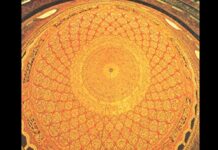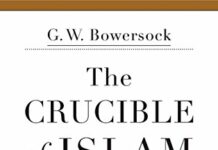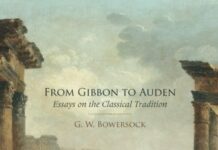
Ebook Info
- Published: 2012
- Number of pages: 128 pages
- Format: PDF
- File Size: 2.96 MB
- Authors: G. W. Bowersock
Description
In this book, based on lectures delivered at the Historical Society of Israel, the famed historian G. W. Bowersock presents a searching examination of political developments in the Arabian Peninsula on the eve of the rise of Islam. Recounting the growth of Christian Ethiopia and the conflict with Jewish Arabia, he describes the fall of Jerusalem at the hands of a late resurgent Sassanian (Persian) Empire. He concludes by underscoring the importance of the Byzantine Empire’s defeat of the Sassanian forces, which destabilized the region and thus provided the opportunity for the rise and military success of Islam in the seventh century. Using close readings of surviving texts, Bowersock sheds new light on the complex causal relationships among the Byzantine, Ethiopian, Persian, and emerging Islamic forces.
User’s Reviews
Editorial Reviews: Review “Bowersock has brought a novel freshness to this grand narrative. He fastens with delight on new pieces of evidence, from each of which he derives conclusions that significantly alter our view of the whole story.”– “The New York Review of Books””The author, a historian Of Greco-Roman times, shows how edges of empires help us understand the inner workings of the empires themselves.”– “Saudi Aramco World” Review “Glen Bowersock turns topics that are marginal to traditional ancient history into mainstream subjects, and thereby brings new ideas into play. Thus he inspires numerous others to continued research. Religion, wars, and empires in the late antique Near East are reinterpreted. Momentous events, the results of which we can still witness, are here described in a concise and eminently readable account.” (Benjamin Isaac, Tel Aviv University)“Bowersock is the master of connecting scholars from all over the world with each other and with their work. [He] has been an authoritative and prestigious go-between . . . These connections and new wholes run the entire length of Bowersock’s scholarly activities and publications . . . , bringing together apparently disparate elements into a cultural understanding.” (From the foreword by Albert I. Baumgarten, professor emeritus, Bar Ilan University) About the Author G. W. BOWERSOCK is professor emeritus of ancient history at the Institute for Advanced Study, Princeton, New Jersey. His most recent book is From Gibbon to Auden: Essays on the Classical Tradition. Read more
Reviews from Amazon users which were colected at the time this book was published on the website:
⭐I have read this booklet, as the
⭐before, in order to learn more about the conquest of the kingdom of Himyar by Axum. It consists basically of a collection of three lectures given by Glen W. Bowersock in Jerusalem in 2011, and the first lecture in it is then also exactly about this subject. Justinian saw a chance to persuade the Ethiopian negus to invade the Jewish kingdom at the Southern tip of the Arabian peninsula in order to wage a proxy war against Persia. The problem of this was only that the new Hymarite client king quickly wanted to assert his independence, and once this happened, he was too weak to withstand the Persians. The whole operation thus only lead to a power vacuum in Himyar, which the Persians could effectively use to extend their influence until the Southern tip of Arabia. At this time point, the Arabs of Mecca and Medina had the Persians and the Byzantines at both ends of their sphere of influence, respectively, which might have influenced their actions.The second lecture is about the Persian conquest of Jerusalem in 614. Glen W. Bowersock can nicely show that the Persian capture of Jerusalem in 614 was not as brutal or destructive, as maintained in the sources and also in a lot of current history books, where stories of atrocities on the Christians by the Jewish inhabitants of Jerusalem still prevail. The third lecture is about the fact, that the Arabs initially were thankful of Heraclius’ defeat of the Persians, as stated in Sura 30 on Rûm, as with this victory, he crushed the Persian central state and enabled the Arabs thereafter to quickly overcome the Persian resistance and to conquer their empire. Only later, when the Byzantines were the only enemy of the Arabs, did they turn into the main enemy and was the Sura thus read in a different light. But in the beginning, for a short time, Arabs and Byzantines were like natural allies.All in all, this small booklet with three lectures about the interactions between Byzantines, Persians and Arabs in the sixth and early seventh is a worthwhile read.
⭐I have been studying the relations between the Eastern Roman Empire and the nascent Islamic caliphates during late antiquity and the early medieval period. This book “Empires in Collision” is a series of 3 lectures delivered at the Historical Society of Israel in 2011. While an interesting albeit short read, it did not delve deeply enough into the minutiae of early Arab/Christian relations which I am interested in.
⭐It gave me a lot of information about that period of history. But is was different from the book, under the shadow of the sword by Tom Holland.I need to investigate this topic further.
⭐Nice to have these lectures in book form.
⭐Excellent book by a top historian in the field.
⭐OK, but better books are those of Peter Brown and Eline Pagles (sp).
⭐This little booklet – less than 100 pages all told – contains three lectures delivered in 2011 by G.W. Bowerstock which, to some extent, are complemented by his more recent book, “The Throne of Adulis”.The first lecture is about Byzantium, Ethiopia (Axoum) and the Jewish Kingdom of South Arabia, which was backed by the Sassanians and attacked and invaded by Christian Axoum, supported by Justinian’s East Roman (or Early Byzantine) Empire. While there is not a huge amount of evidence, the author makes the most of what there is in his effort to reconstitute the main events of the power struggle which opposed the allies of the respective superpowers and which influenced pre-Islamic and early Islamic Arabia.The second lecture is centred on the Persian capture of Jerusalem by the Persians in 614, following a crushing defeat suffered at the hands of the Sassanians by Emperor Heraclius the year before. The interesting bit is the role of the Jews still living in Jerusalem who clearly favoured the Persians and welcomed them. Given the treatment meted out by the Romans to them, this is hardly surprising. The Christian population, mainly Monophysites, do not seem to have put up a fierce resistance, partly because they were alienated from Constantinople for religious reasons but also, as the lecturer shows, because the Persians were careful not to alienate them. They seem to have mainly governed occupied Egypt, Palestine and Syria through the existing administrative local structures and, although they were some massacres and initial pillaging, this seems to have been kept to a minimum.The third lecture titled “Heraclius’ gift to Islam: the Death of the Persian Empire”, is the most intriguing of the three. Here the author argues that, by weakening and almost destroying the Persian Empire as a result of the long war that he finally won, Emperor Heraclius, quite accidentally, played into the hands of the early Arab conquerors. What is more original, however, are the traces that can be found in some of the earliest Islamic writing (and one of the surates, in particular) of praise and rejoicing at the victory of the Byzantine monotheist Emperor over the pagan Persians. This seems to have happened just a few years before the Arab onslaught on Palestine and Syria begun. It also suggests that, at least initially, there was not the irreconcilable hostility and hatred that would develop after the first invasions.In all three cases, the lectures are clear, concise and to the point and read as vignettes, giving us three glimpses of “Empires in Collision”, each with its religion. A solid four stars.
⭐This little booklet – less than 100 pages all told – contains three lectures delivered in 2011 by G.W. Bowerstock which, to some extent, are complemented by his more recent book, “The Throne of Adulis”.The first lecture is about Byzantium, Ethiopia (Axoum) and the Jewish Kingdom of South Arabia, which was backed by the Sassanians and attacked and invaded by Christian Axoum, supported by Justinian’s East Roman (or Early Byzantine) Empire. While there is not a huge amount of evidence, the author makes the most of what there is in his effort to reconstitute the main events of the power struggle which opposed the allies of the respective superpowers and which influenced pre-Islamic and early Islamic Arabia.The second lecture is centred on the Persian capture of Jerusalem by the Persians in 614, following a crushing defeat suffered at the hands of the Sassanians by Emperor Heraclius the year before. The interesting bit is the role of the Jews still living in Jerusalem who clearly favoured the Persians and welcomed them. Given the treatment meted out by the Romans to them, this is hardly surprising. The Christian population, mainly Monophysites, do not seem to have put up a fierce resistance, partly because they were alienated from Constantinople for religious reasons but also, as the lecturer shows, because the Persians were careful not to alienate them. They seem to have mainly governed occupied Egypt, Palestine and Syria through the existing administrative local structures and, although they were some massacres and initial pillaging, this seems to have been kept to a minimum.The third lecture titled “Heraclius’ gift to Islam: the Death of the Persian Empire”, is the most intriguing of the three. Here the author argues that, by weakening and almost destroying the Persian Empire as a result of the long war that he finally won, Emperor Heraclius, quite accidentally, played into the hands of the early Arab conquerors. What is more original, however, are the traces that can be found in some of the earliest Islamic writing (and one of the surates, in particular) of praise and rejoicing at the victory of the Byzantine monotheist Emperor over the pagan Persians. This seems to have happened just a few years before the Arab onslaught on Palestine and Syria begun. It also suggests that, at least initially, there was not the irreconcilable hostility and hatred that would develop after the first invasions.In all three cases, the lectures are clear, concise and to the point and read as vignettes, giving us three glimpses of “Empires in Collision”, each with its religion. A solid four stars.
⭐The book is based on 3 lectures by the author (in Jerusalem).It develops the confrontation between the Sassanid, Roman (Greek) and Ethiopian empires, and the role of the small kingdoms in-between (ex Himyar). Confrontation not only of empires, but also of religions, with a strong Jewish presence, Christians of various affiliations, and Zoroastrians. As you would have guessed the book sets the environment in which Muhammad grew and developed his message.It is a fairly good introduction to the subject.
⭐Ces conférences sur les événements géopolitiques de l’Antiquité Tardive qui mettent aux prises l’Empire Perse, Byzance et le Royaume d’Ethiopie sont proprement passionnantes, prenant à contre-pied nombre de préjugés contemporains sur ces époques décisives et pourtant si mal connues !Glen Bowersock est un très très grand historien !I didn’t know, that a very important precondition for the rapid Arab expansion into the Persian empire was the Byzantine defeat of the Persian army at Ctesiphon in 628.I already recommend this book to others.
Keywords
Free Download Empires in Collision in Late Antiquity (The Menahem Stern Jerusalem Lectures) in PDF format
Empires in Collision in Late Antiquity (The Menahem Stern Jerusalem Lectures) PDF Free Download
Download Empires in Collision in Late Antiquity (The Menahem Stern Jerusalem Lectures) 2012 PDF Free
Empires in Collision in Late Antiquity (The Menahem Stern Jerusalem Lectures) 2012 PDF Free Download
Download Empires in Collision in Late Antiquity (The Menahem Stern Jerusalem Lectures) PDF
Free Download Ebook Empires in Collision in Late Antiquity (The Menahem Stern Jerusalem Lectures)





